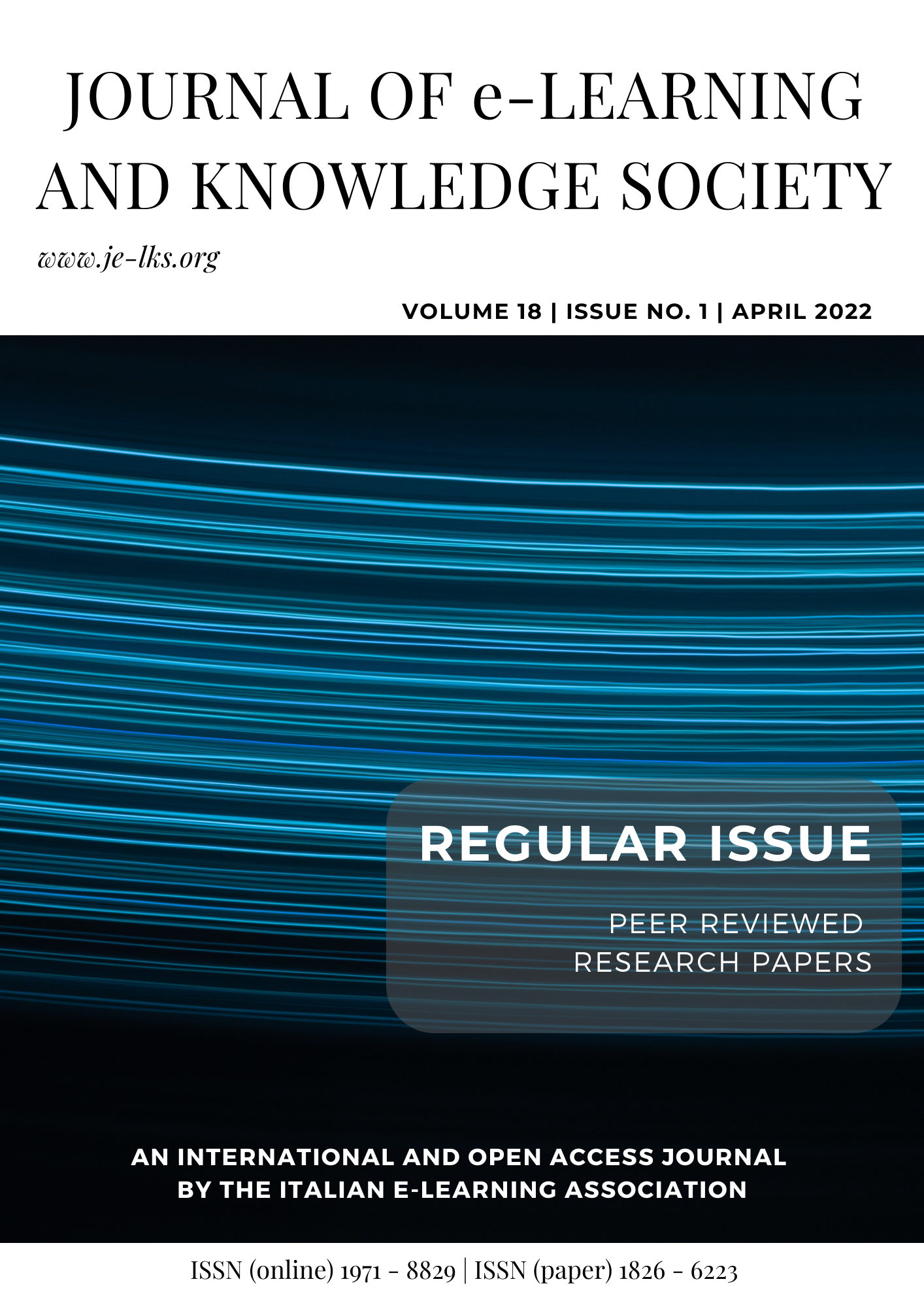Main Article Content
Abstract
The article presents the validation of an instrument for the assessment of students’ perception of the university climate in distance education settings. Also in such contexts, students establish relationships with classmates and teachers, and feel the atmosphere, the sense of belonging to an institution and to a community of learners. For teachers, however, it is difficult to understand how students perceive these dynamics. Therefore, the University Climate Questionnaire for Distance Education Contexts (UCliQ-DE), composed of 22 items, has been developed and validated through factorial analysis and reliability studies among a population of freshmen in an Italian BA program in Educational Sciences. It was concluded that the UCliQ-DE is a valid and reliable assessment tool, and that it yields five interpretable factors: the perception of the relationships among students, the sense of belonging to the academic community, the previous expectations about the online university climate, the perception of the relationships between students and teachers, and the awareness of the potential limits of online interactions.
Keywords
Article Details

This work is licensed under a Creative Commons Attribution-NonCommercial-ShareAlike 4.0 International License.
The author declares that the submitted to Journal of e-Learning and Knowledge Society (Je-LKS) is original and that is has neither been published previously nor is currently being considered for publication elsewhere.
The author agrees that SIe-L (Italian Society of e-Learning) has the right to publish the material sent for inclusion in the journal Je-LKS.
The author agree that articles may be published in digital format (on the Internet or on any digital support and media) and in printed format, including future re-editions, in any language and in any license including proprietary licenses, creative commons license or open access license. SIe-L may also use parts of the work to advertise and promote the publication.
The author declares s/he has all the necessary rights to authorize the editor and SIe-L to publish the work.
The author assures that the publication of the work in no way infringes the rights of third parties, nor violates any penal norms and absolves SIe-L from all damages and costs which may result from publication.
The author declares further s/he has received written permission without limits of time, territory, or language from the rights holders for the free use of all images and parts of works still covered by copyright, without any cost or expenses to SIe-L.
For all the information please check the Ethical Code of Je-LKS, available at http://www.je-lks.org/index.php/ethical-code
References
- Barbaranelli, C. (2003). Analisi dei dati. Tecniche multivariate per la ricerca psicologica e sociale. LED.
- Casas, J.A., Del Rey, R., Ortega-Ruiz R. (2013). Bullying and cyberbullying: Convergent and divergent predictor variables. Computers in Human Behavior, 29(3), 580-587. https://doi.org/10.1016/j.chb.2012.11.015
- Conley, C.S., Travers, L.V., Bryant, F.B. (2013). Promoting psychosocial adjustment and stress management in first-year college students: The benefits of engagement in a psychosocial wellness seminar. Journal of American College Health, 61(2), 75-86. https://doi.org/10.1080/07448481.2012.754757
- De Lillo, A., Argentin, G., Lucchini, M., Sarti, S., Terraneo, M. (2007). Analisi multivariata per le scienze sociali. Pearson.
- Felini, D., Zobbi, E. (in preparation). The university climate in a group of freshmen during the pandemic: Attitudes, expectations, and social interactions in a distance education setting.
- Li, D., Zhou Y., Li X., Zhou Z. (2016). Perceived school climate and adolescent internet addiction: The mediating role of deviant affiliation and the moderating role of effortful control. Computers in Human Behavior, 60, 54-61. https://doi.org/10.1016/j.chb.2016.02.015
- Machado, C.A., Almeida, L.S., Soares, A.P.C. (2002). Academic experience at the beginning and the end of university studies. European Journal of Education, 37(4), 387-394. https://doi.org/10.1111/1467-3435.00117
- Di Franco, G., Marradi, A. (2003) Analisi fattoriale e analisi in componenti principali. Bonanno.
- Gunuc, A., Huseyin, A., Yigit E., Keser, H. (2022). Examining the Relationship Between Student Engagement and Campus Climate: A Case in Turkey. Journal of College Student Retention: Research, Theory & Practice, 23(4), 1100-1119. https://doi.org/10.1177/1521025119894579
- Jean-Francois, E. (2019). Exploring the perceptions of campus climate and integration strategies used by international students in a US university campus. Studies in Higher Education, 44(6), 1069-1085. https://doi.org/10.1080/03075079.2017.1416461
- Kurt, Y., Özkan, Ç.G., Öztürk, H. (2022). Nursing students’ classroom climate perceptions: A longitudinal study. Nurse Education Today, 111, 1-7. https://doi.org/10.1016/j.nedt.2022.105311
- McMillan, D.W. & Chavis, D.M. (1986). Sense of community: A definition and theory. Journal of Community Psychology, 14(1), 6-23. https://doi.org/10.1002/1520-6629(198601)14:1%3c6::AID-JCOP2290140103%3e3.0.CO;2-I
- Munawar, R., Inam-ul-haq, M.A., Ali S., Maqsood, H. (2014). Incidence, nature and impacts of cyber bullying on the social life of university students. World Applied Sciences Journal, 30(7), 827-830.
- Rania, N., Siri, A., Bagnasco, A., Aleo, G., Sasso, L. (2014). Academic climate, well-being and academic performance in a university degree course. Journal of Nursing Management, 22(6), 751-760. https://doi.org/10.1111/j.1365-2834.2012.01471.x
- Rovai, A.P. (2002). Development of an instrument to measure classroom community. Internet and Higher Education, 5, 197-211. https://doi.org/10.1016/S1096-7516(02)00102-1
- Qazi, A., Tamjidyamcholo, A., Gopal Raj, R., Hardaker, G., Standing, C. (2017). Assessing consumers' satisfaction and expectations through online opinions: Expectation and disconfirmation approach. Computers in Human Behavior, 75, 450-460. http://dx.doi.org/10.1016/j.chb.2017.05.025
- Sánchez, C.R., Ortiz, D.C., Gonzales Carrasco, M., Carbo, A.P., Pérez Burriel, M. (2015). A tool for assessing social climate in university classrooms. Electronic Journal of Research in Educational Psychology, 13(2), 387-408. http://dx.doi.org/10.14204/ejrep.36.14075
- Santinello, M., Bertarelli, P. (2002). La scuola come setting. In M. Prezza & M. Santinello (Eds.), Conoscere la comunità. L’analisi degli ambienti di vita quotidiana. Il Mulino.
- Souza, S.B., Veiga Simão, A.M., Ferreira, A.I. & Costa Ferreira, P. (2018). University students’ perceptions of campus climate, cyberbullying and cultural issues: Implications for theory and practice. Studies in Higher Education, 43(11), 2072-2087. https://doi.org/10.1080/03075079.2017.1307818

